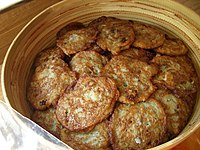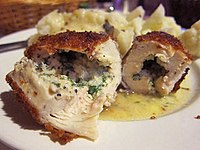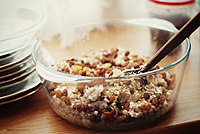Ukrainian cuisine

| Part of a series on the |
| Culture of Ukraine |
|---|
 |
| Cuisine |
Ukrainian cuisine is the collection of the various cooking traditions of the people of Ukraine, one of the largest and most populous European countries. It is heavily influenced by the rich dark soil (chornozem) from which its ingredients come, and often involves many components.[1] Traditional Ukrainian dishes often experience a complex heating process – "at first they are fried or boiled, and then stewed or baked. This is the most distinctive feature of Ukrainian cuisine".[2]
The national dish of Ukraine is red borscht, a well-known beet soup, of which many varieties exist. However, varenyky (boiled dumplings similar to pierogi) and a type of cabbage roll known as holubtsi are also national favourites, and are a common meal in traditional Ukrainian restaurants.[3] These dishes indicate the regional similarities within Eastern European cuisine.
The cuisine emphasizes the importance of wheat in particular, and grain in general, as the country is often referred to as the "breadbasket of Europe".[4] The majority of Ukrainian dishes descend from ancient peasant dishes based on plentiful grain resources such as rye, as well as staple vegetables such as potato, cabbages, mushrooms and beetroots. Ukrainian dishes incorporate both traditional Slavic techniques as well as other European techniques, a byproduct of years of foreign jurisdiction and influence. As there has been a significant Ukrainian diaspora over several centuries (for example, over a million Canadians have Ukrainian heritage), the cuisine is represented in European countries and those further afield, particularly Argentina, Brazil, and the United States.
History
[edit]This section needs expansion. You can help by adding to it. (August 2024) |
Soups
[edit]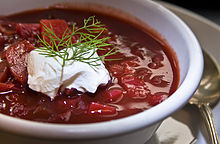
Borscht
[edit]Although the word borscht usually refers to the red variety, it may also refer to other sour soups that may not have any beets in them.
- Chervonyi borshch (red borscht; usually simply called borshch) is a vegetable soup made out of beets, cabbage, potatoes, tomatoes, carrots, onions, garlic, dill.[5][6] There are about 30 varieties of Ukrainian borscht.[6] It may include meat or fish.[5] Although the modern variety is usually soured with tomatoes or tomato-derived products (such as tomato paste), traditionally beet kvas was used instead.[7]
- Zelenyi borshch (green borscht) or shchavlevyi borshch (sorrel soup): water or broth based soup with sorrel and various vegetables, served with chopped hard-boiled egg and sour cream.
- Kholodnyi borshch (cold borscht) or kholodnyk: vegetable and beet soup blended with sour dairy (sour cream, soured milk, kefir, or yogurt), served cold with a hard-boiled egg.
- Bilyi borshch (white borscht): refers to different soups depending on the region. In southern Podolia, white borscht is cooked with fresh sugar beets, beans, and vegetables.[8] In the Hutsul region, it is cooked with fermented white beets and their liquid (kvas), onions, carrots, sour cream, and Carpathian oregano.[9] In Polesia, it includes sugar beets, beet kvas, cabbage, mushrooms, potatoes and fresh herbs.[10] White borscht may also refer to a żur-like soup from neighboring Poland.
Other soups
[edit]
- Horokhovyi sup: soup made with dried peas and vegetables, often served with pieces of toasted bread.
- Hrechanyi sup: soup made with buckwheat, vegetables, and sometimes meat.
- Kapusniak: soup made with cabbage, pork, salo, beans, and served with smetana (sour cream).
- Rosolnyk: soup with pickled cucumbers.
- Solianka: thick, spicy and sour soup made with meat, fish or mushrooms and various vegetables and pickles.
- Yushka: clear soup; the most common variety — rybna yushka (fish yushka) is made from various types of fish such as carp, bream, wels catfish, or even ruffe. Another common variety is hrybna yushka (clear mushroom soup).
- Zatirka: vegetable or meat soup with dough pellets that are formed by rubbing the dough with two hands.
Salads and appetizers
[edit]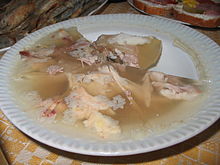
- Brynza or bryndza: white cow or sheep cheese from the Carpathians.
- Kovbasa: various kinds of smoked or boiled pork, beef or chicken sausage. One specific variety is krovianka, the blood sausage.
- Salo: cured fatback. Usually served sliced, with pieces of bread, onion, and horseradish or hot mustard sauce. It may also be fried (shkvarky) or boiled.
- Kaviar or ikra: caviar, served on top of buttered slices of bread.
- Kholodets: aspic (studenets) made with meat or fish (zalyvna ryba).
- Olivier: salad made out of cooked and chopped potatoes, dill pickles, boiled chopped eggs, cooked and chopped chicken or ham, chopped onions, peas, mixed with mayonnaise.
- Vinehret: salad with cooked and shredded beets, sauerkraut, cooked and chopped potatoes, onions, and carrots, sometimes pickles mixed with some sunflower oil and salt.
Bread and grain
[edit]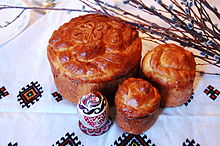
Bread and wheat products are important to Ukrainian cuisine. The country has been considered one of the traditional "breadbaskets" of the world.[11] Decorations on the top can be elaborate for celebrations.
- Babka: Easter bread, usually a sweet dough with raisins and other dried fruit. It is usually baked in a tall, cylindrical form.
- Bublyk: ring-shaped bread roll made from dough that has been boiled before baking. It is similar to bagel, but usually somewhat bigger and with a wider hole.
- Kolach: ring-shaped bread typically served at Christmas and funerals. The dough is braided, often with three strands representing the Holy Trinity. The braid is then shaped into a circle (circle = kolo in Ukrainian) representing the circle of life and family.
- Korovai: a round, braided bread, similar to the kolach. It is most often baked for weddings and its top decorated with birds and periwinkle.
- Palianytsia: regular baked bread (famously difficult to pronounce for non-Ukrainian speakers).
- Savory pampushky: soft, fluffy bread portions, or deep-fried pieces of dough, topped with garlic butter.
- Paska: traditional rich pastry baked on Easter.
Main courses
[edit]
- Banush or banosh: a cornmeal stew.
- Chicken Kyiv (kotleta po-kyivsky): Kyiv-style chicken cutlet filled with butter and fresh herbs.
- Deruny: potato pancakes, usually served with sour cream.
- Fish (ryba): fried in egg and flour; cooked in oven with mushrooms, cheese, and lemon; pickled, dried or smoked variety.
- Holubtsi: cabbage leaves, or sometimes vine leaves (fresh or preserved) rolled with rice or millet filling that may contain meat (minced beef or bacon), baked in oil and caramelized onions and may contain as a baking sauce tomato soup, cream or sour cream, bacon drippings or roasted with bacon strips on top.[12]
- Huliash: refers to stew in general, or specifically Zakarpattian variety of Hungarian goulash.
- Kasha: porridge, usually made out of buckwheat, wheat, barley, rye, millet, rice, oat, or corn. One specific variety is kasha hrechana zi shkvarkamy (buckwheat cereal with fried pork rinds and onion).
- Kartoplianyky: fried balls of potato mash with flour and eggs; may have a filling.
- Kotlety or sichenyky (cutlets, meatballs): minced meat or fish mixed with onions, raw eggs, breadcrumbs or bread, and sometimes garlic and milk, fried in oil and sometimes rolled in breadcrumbs.
- Kruchenyky or zavyvantsi: pork or beef rolls with various stuffing: mushrooms, onions, eggs,[13] cheese, prunes, sauerkraut, carrots, etc.
- Mlyntsi: thin pancakes, similar to French crêpes, Russian bliny, or Ashkenazi Jewish blintz. Stuffed mlyntsi are called nalysnyky, and they are usually filled with quark, meat, cabbage, or fruits, and served with sour cream.
- Potato (kartoplia, also dialectally barabolia, bulba, krumplia, mandeburka): young or peeled, served with butter, sour cream, dill; a more exclusive variety includes raw egg. May be boiled, fried, baked, or mashed.
- Pyrizhky: baked buns stuffed with different fillings, such as ground meat, liver, eggs, rice, onions, fried cabbage or sauerkraut, quark, cherries etc.
- Pyrih: a big pie with various fillings.
- Roast meat (pechenia): pork, veal, beef or lamb roast.
- Smazhenyna: fried meat.
- Stuffed duck or goose with apples.
- Varenyky: dumplings made with fillings[5][6] such as mashed potatoes and fried onions, boiled ground meat and fried onions, liver and fried onions, fried cabbage with fried onions, quark, cherries, and strawberries. Served with sour cream and butter or sugar, when filled with fruits.
-
Deruny in a traditional crockery dish
-
Kotleta po-kyivsky (Kyiv-style chicken)
Desserts
[edit]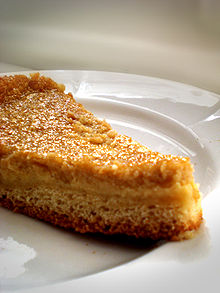
- Kutia: traditional Christmas dish, made of poppy seeds, wheat, nuts, honey, and delicacies.[14]
- Kyiv cake: creamy dessert consisting of two layers of meringue with hazelnuts and a buttercream filling.
- Medivnyk or medovyk: honey cake.
- Molozyvo: dish made by baking a beestings and egg mixture.
- Sweet pampushky: sweet dough similar to doughnut holes. Frequently tossed with sugar. Traditionally filled with rose preserve, but can also be filled with poppy seed or other sweet fillings.
- Pinnyk: berry mousse.
- Ptashyne moloko (literally: bird's milk): milk soufflé with chocolate coating.
- Smetannyk: soft cake made with sour cream.
- Syrnyky: fried quark fritters, sometimes with raisins, served with sour cream, jam (varennia), honey or apple sauce.
- Tort: many varieties of layered cakes, from moist to puffy, most typical ones being Kyivskyi, Prazhskyi, and Trufelnyi. They are frequently made without flour, instead using ground walnuts or almonds.
- Varennia: a whole fruit preserve made by cooking berries and other fruits in sugar syrup.
- Vatrushka: pastry with sweet quark filling.
- Verhuny: crispy deep-fried pastry, similar to angel wings.
- Zhele (plural and singular): jellied fruits, like cherries, pears, etc.
- Zefir: soft dessert made from fruit or berry puree, sugar and egg whites. Similar to meringue.
-
Syrnyky with raisins
Beverages
[edit]
Alcoholic
[edit]- Horilka: strong spirit of industrial production or its home-made equivalent – samohon (moonshine) is also popular, including with infusions of fruit, spices, herbs or hot peppers. One of the most exotic is flavoured with honey and red pepper.
- Beer (pyvo): the largest producers of beer are Obolon, Lvivske, Chernihivske, Slavutych, Sarmat, and Rogan, which partly export their products.
- Wine (vyno): from Europe and Ukraine (particularly from Crimea), mostly sweet. See Ukrainian wine.
- Mead (med or medukha): a fermented alcoholic beverage made from honey, water, and yeast. Its flavour depends on the plants frequented by the honeybees, the length of time and method of aging, and the specific strain of yeast used. Its alcohol content will vary from maker to maker depending on the method of production.
- Nalyvka: a homemade wine made from cherries, raspberries, gooseberries, bilberries, blackberries, plums, blackthorns or other berries or fruits. Berries were put into a sulija (a big glass bottle), some sugar was added. After the berries fermented, the liquid was separated from the berries, and put into corked bottles. The berries were used to make pyrizhky (baked or fried pastry). The wine has about 15% of alcohol.
Non-alcoholic
[edit]
- Mineral water: well-known brands are Truskavetska, Morshynska, and Myrhorodska. They usually come strongly carbonated.
- Kompot: a sweet beverage made of dried or fresh fruits or berries boiled in water.
- Uzvar: a specific type of kompot made of dried fruit, usually apples, pears, and/or prunes. Traditionally served on Christmas.
- Kysil: a kompot that is thickened with potato starch.
- Kvas: a sweet-and-sour sparkling beverage brewed from yeast, sugar, and dried rye bread.
- Kefir:[5] milk fermented by both yeast and lactobacillus bacteria, that has a similar taste to yogurt. Homemade kefir may contain a slight amount of alcohol.
- Pryazhene moloko: baked milk, a milk product that has a creamy colour and a light caramel flavour. It is made by simmering milk on low heat for at least eight hours.
- Ryazhanka: fermented baked milk.
- Syta: water with honey.
See also
[edit]- Culinary arts
- Mushroom picking in Slavic culture
- Twelve-dish Christmas Eve supper
- Cuisine of Odesa
- Olha Franko
References
[edit]- ^ "Food in Ukraine – Ukrainian Food, Ukrainian Cuisine – traditional, popular, dishes, recipe, diet, history, common, meals, staple". www.foodbycountry.com.
- ^ "Ukrainian National Food and Cuisine". ukrainetrek.com.
- ^ "5 Best Ukraine traditional Foods".
- ^ "The Bread Basket of Europe". InfoPlease.
- ^ a b c d "Cuisine – Flavors and Colors of Ukrainian Culture." Ukraine.com. Accessed July 2011.
- ^ a b c "Ukraine National Food, Meals and Cookery." Ukrainetrek.com. Accessed July 2011.
- ^ Artiukh, Lidiia (1977). Українська народна кулінарія. Історико-етнографічне дослідження [Ukrainian folk cooking. Historic-ethnographic research]. Kyiv: Naukova Dumka. pp. 53–55.
- ^ Volodymyrova, Vitalina (26 September 2020). Цукровий буряк у борщ додають на півдні Вінниччини [Sugar beet is added to borscht in southern Vinnytsia Oblast]. 33 Kanal.
- ^ Гуцульський борщ з білим буряком. Неймовірний рецепт з Карпат [Hutsul borscht with white beetroot. Exceptional recipe from the Carpathians]. Nashi Besahy. 18 February 2018.
- ^ Maslova, Iryna (23 September 2022). На Житомирщині приготували автентичний борщ незвичайного кольору [In Zhytomyr Oblast, they cooked an authentic borscht of an unusual color]. Shuba.
- ^ Merrill, Lorraine (2003). "Environment". In Katz, Solomon (ed.). Encyclopedia of Food and Culture. Vol. 1. New York: Charles Scribner's Sons. p. 576. ISBN 0-684-80565-0.
- ^ Pochle͏̈bkin, Vilʹjam V. (1988). Nationale Küchen die Kochkunst der sowjetischen Völker (2., überarb. Aufl ed.). Moskau. ISBN 978-3-7304-0053-1. OCLC 75011701.
{{cite book}}: CS1 maint: location missing publisher (link) - ^ Stuffed Pork Rolls with Mushrooms (Kruchenyky). Enjoyyourcooking.com (2010-11-20). Retrieved on 2016-12-17.
- ^ Recipe: Kutia, Star of the Ukrainian Christmas Eve Supper Archived 2019-11-14 at the Wayback Machine. Sovabooks.com.au. Retrieved on 2016-12-17.
Further reading
[edit]- UCWL Cook Book. Ukrainian Traditional and Favourite Recipes. — Yorkton : The Ukrainian Catholic Women's League, 1970. — 111 p.
- Artiukh, Lidia 1977, Ukrainska Narodna Kulinaria [Ukrainian Folk Cuisine], Naukova Dumka, Kyiv
- Artiukh, Lidia 2001, Ukrainian Cuisine and Folk Traditions, Baltija-Druk, Kyiv
- Corona, Annette 2012, The New Ukrainian Cookbook, Hippocrene Books, New York
- Faryna, Natalka (ed.) 1976, Ukrainian Canadiana, Ukrainian Women's Association of Canada, Edmonton
- Stechishin, Savella 1959, Traditional Ukrainian Cookery, Trident Press, Winnipeg
- Stechishin, Savella 2007, “Traditional Foods" Encyclopedia of Ukraine (Retrieved 2007-08-10)
- Tracz, Orysia 2015, First Star I See Tonight, Mazepa Publications Zhuravli, Winnipeg
- Ukrainian Food, Ukrainian International Directory
- Ukrainian Women's Association of Canada, Daughters of Ukraine Branch 1984, Ukrainian Daughters' Cookbook, Centax of Canada, Winnipeg
- Yakovenko, Svitlana 2013, Taste of Ukraine: Rustic Cuisine from the Heart of Ukraine, Sova Books, Sydney
- Yakovenko, Svitlana 2016, Ukrainian Christmas Eve Supper: Traditional village recipes for Sviata Vecheria, Sova Books, Sydney (e-format edition)
- Ukrainian Traditional Food: Tasty, Fun, with a Twinkle!. — Best Kyiv Guide: March 30, 2020 p.

